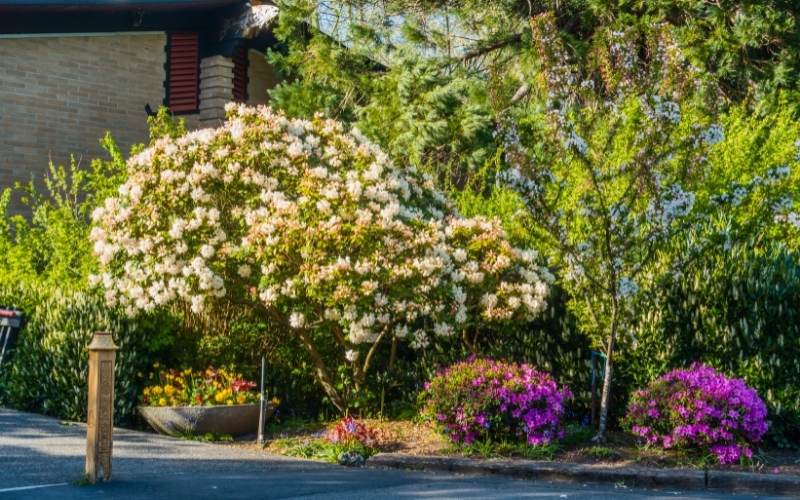
Spring is the season of flowers, fall is the season of leaf colors, and summer? You can brighten up the hot season with summer-flowering shrubs with generous blooms like hibiscus, oleander and even roses, all plants that like to blossom in sunny days.
These low-maintenance bushes will delight you with their abundant blooms throughout the summer, so you can have an incredible garden from early summer to late summer and even into the fall with little or no maintenance!
Not only they ideal for busy gardeners who don’t have time to keep their hedges and borders fresh and interesting with more demanding annuals and perennials, these long-blooming beauties will also create a haven for wildlife and pollinators, like hedgehogs, birds, butterflies and bees.
To give you a little inspiration, here are 14 amazing flowering shrubs that will add long-lasting summer color to your garden, all with landscaping and design ideas and handy gardening tips
I am sure that you will be hard put to pick just one, and let me show you why…
1. ‘Incrediball’ Smooth Hydrangea (Hydrangea arborescens ‘Incrediball’)
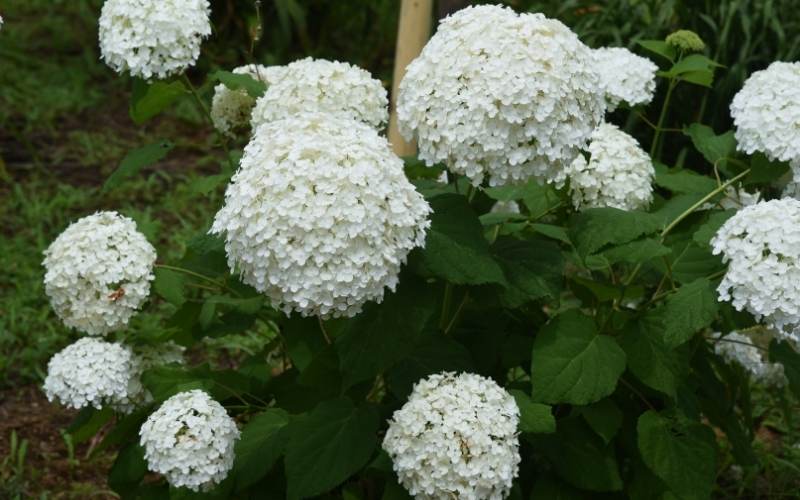
‘Incrediball’ is a very generous cultivar of hydrangea with long lasting summer blooms. Starting early in the season this deciduous flowering shrub will cover in large spherical inflorescences of white flowers that can reach one foot in diameter (30 cm)!
They will start off with a lime green hue and turn to snow as they open. Set on the emerald green and lush foliage of this shade loving plant, they give you a sense of freshness and candor just when the Sun is hot and and high in the sky.
‘Incrediball’ is a fast growing shrub that suits all traditional and informal designs; plant it under trees alone or in groups, in hedges and screens to give brightness and a sense of cool to your garden.
But this old hardy variety is small enough to grow in containers, so, good for patios and terraces as well.
2. ‘Little Lucky Red’ Bigleaf Lantana (Lantana ‘Little Lucky Red’)
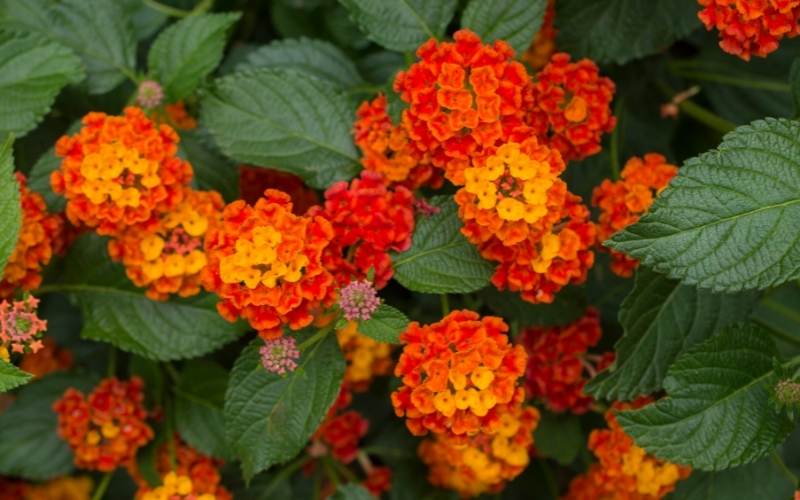
‘Little Lucky Red’ is our choice of lantana for summer gardens because its colors really suit this season. The round clusters of flowers contain orange red, orange and orange yellow flowers, in this order from outside to inside.
What better choice to bring out the hot feeling and shades of summer days? They will come in great profusion all through the warm months, starting in late spring and opening all the way to fall. It is a dwarf variety, so it is perfect for modest places.
Tiny but beautiful, ‘Little Lucky Red’ lantana will brighten up small borders but also flower beds with its warm presence. And if all you have is even a small terrace, or even a window sill, this is by far your best choice.
3. ‘Sunset’ Rock Rose (Cistus x pulverulentus ‘Sunset’)
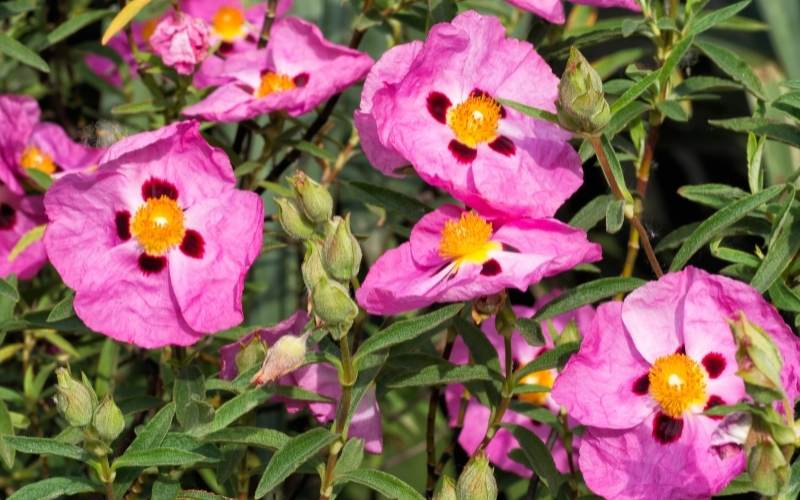
‘Sunset’ is an ideal rock rose variety to fill your garden with bright blooms all through the summer months. This low spreading, evergreen shrub has bright magenta flowers with five petals and a golden center that will start blooming late in spring.
Each blossom is about 2 inches across (5.0 cm) and they come in numbers on the surface of the foliage, which is mid green, slightly fuzzy and pointed.
The shrub is herbaceous and wild looking, with a sprawling habit. It is a very low maintenance plant that gives you lot for so very little. It is a winner of the Award of Garden Merit by the Royal Horticultural Society.
‘Sunset’ rock rose is ideal fro natural looking gardens; it has a very unkempt look as a shrub, ideal for borders but also as ground cover and on slopes. It also has great merits as a wall side bush. Its ideal setting is a coastal or Mediterranean garden.
4. ‘Goldfinger’ Shrubby Cinquefoil (Potentilla fructicosa ‘Goldfinger’)
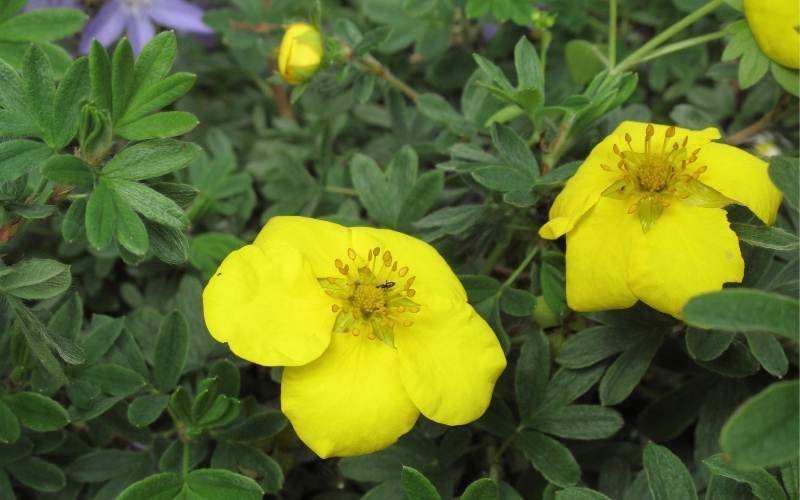
A marathon bloomer to fill your summer garden with bright blooms is ‘Goldfinger’ shrubby cinquefoil, a.k.a. potentilla. The flowers have 5 round petals of about 1.5 inches in diameter (4.0 cm) and they are of the brightest golden yellow. They will appear in large numbers but scattered all over the shrub starting in spring.
The foliage is rich green, quite dense and very thinly textured. The segmented leaves typical of this plant give you a lovely and soft backdrop for the flower display that will continue till frost!
‘Goldfinger’ shrubby cinquefoil is a very easy to grow shrub that brings vitality and energy borders, beds hedges and screens in most informal gardens, but its real vocation are coastal, cottage, courtyard and city gardens.
5. ‘Bloomerang Dark Purple’ Reblooming Lilac (Syringa ‘Dark Purple’)
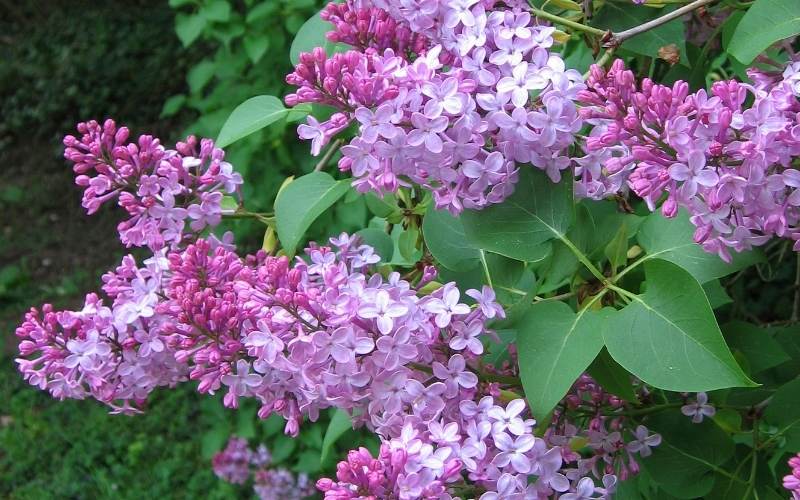
‘Bloomerang Dark Purple’ is a variety of lilac that will flower again and again, all through summer and far beyond. This reblooming lilac cultivar has long and showy dark magenta purple inflorescences that come from the mid green foliage and keep blooming starting from the tips and giving you an intense color and sweet fragrance at the same time.
Butterflies and bees really love this thick shrub with a round habit, and hedgehogs use it as a corridor in rural but also suburban areas.
‘Bloomerang Dark Purple’ is a lilac you want in a natural and even naturalized setting, as foundation planting, in hedges and screens. However, it also adapts to containers for patios and terraces.
6. ‘Maria Stern’ Hybrid Tea Rose (Rosa ‘Maria Stern’)
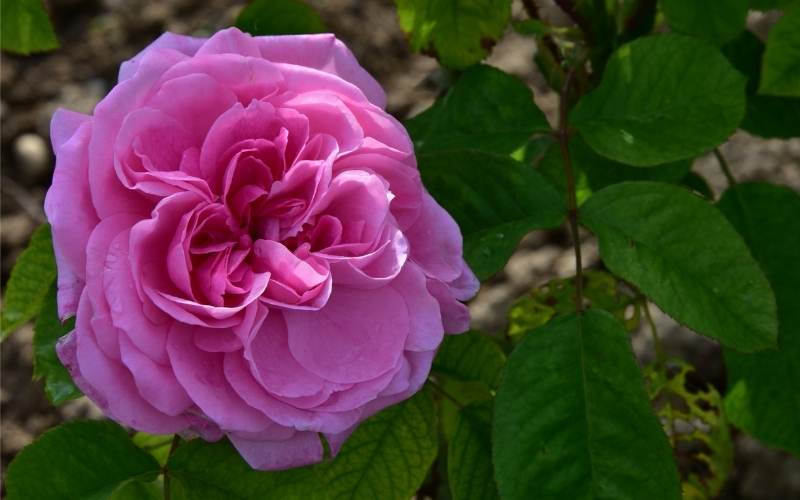
There are many hybrid tea roses that bloom in summer, but we chose the delicate colored ‘Maria Stern’ for the unique and rare shade of coral to apricot blooms. The fully double and tea shaped flowers have up to 5 inches across (12 cm) and have up to 43 petals each.
The foliage is deep green and glossy, and it sets off the elegant blossoms perfectly well. It is not a low maintenance shrub, but it’s not even one of the hardest roses to grow.
But if you are after a very delicate but showy effect, and a refined color, just look at it!
‘Maria Stern’ will fit most informal settings in flower beds or as a protagonists; it grows well in containers, and I would see it next to a bright green lawn or… terra cotta paving, just imagine the elegant touch!
7. ‘Kew Blue’ Bluebeard (Carytoperis x clandonensis ‘Kew Blue’)
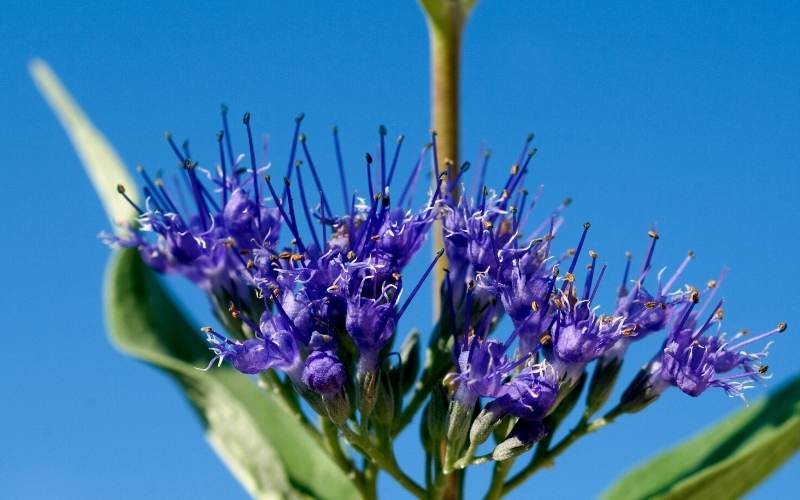
Blue is a less common color in summer, so grow ‘Kew Blue’ bluebeard and you will have in in hordes half though the season and into fall. The inflorescences come at the tips of the upright branches and they are of a very intense and dark sapphire blue shade.
They appear as sparks of color on purplish stems and silver green soft looking deeply serrated foliage. The leaves are also very aromatic, while the blossoms are a favorite with butterflies and hummingbirds!
‘Kew Blue’ bluebeard is an excellent addition to herbaceous borders and at the back of flower beds in informal and naturalistic gardens, from Mediterranean ones to city designs. Ad a wall side bush it is also a touch of vibrant color and soft shapes.
8. ‘Cranberry Crush’ Rose Mallow (Hibiscus ‘Cranberry Crush’)
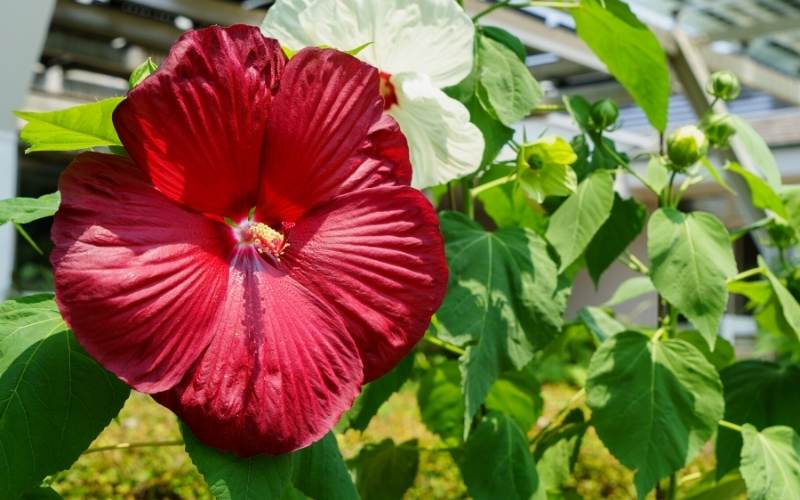
The massive display of showy summer flowers ‘Cranberry Crush’ hibiscus gives you in summer is really hard to match!
The large flowers are round, slightly cupped and about 8 inches across (20 cm) and they have a very deep scarlet red shade, with a velvety texture that gives them lushness.
Each flower head only lasts one day, but this shrub will keep producing new ones for months! They are abundant and perfectly set off by the dense and decorative foliage that is partly green and partly purple.
‘Cranberry Crush’ hibiscus brings passion to informal gardens in beds, borders, containers and as a specimen plant. It suits a range of styles from English country gardens to urban designs. It is also quite cold hardy for a rose mallow.
9. ‘Encore Autumn Ivory’ Reblooming Azalea (Rhododendron ‘Encore Autum Ivory’)
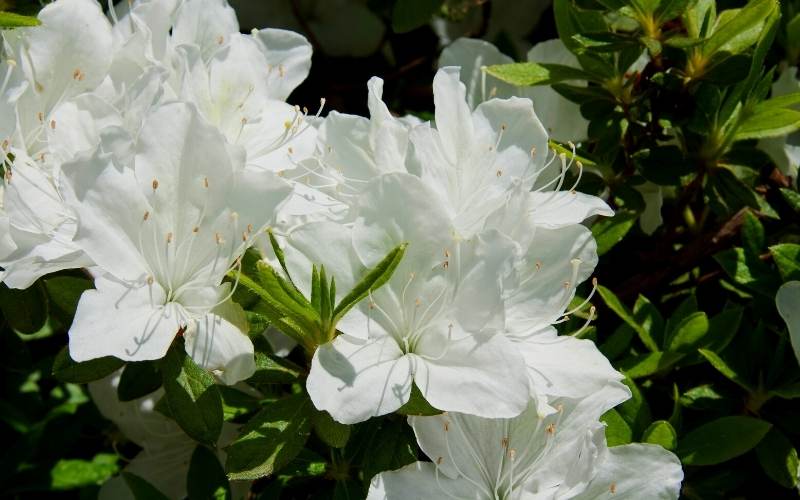
Few azaleas and rhododendrons bloom in summer, but ‘Encore Autumn Ivory’ does! And it will do it with showy snow white flowers that bring light and candor to hot gardens and terraces. Reblooming Azalea come in single heads unlike other plants in this genus, but they stand out perfectly well against the mid green elliptical leaves of its dense and evergreen foliage.
The shrub has an upright habit and a very exotic appearance. Other colors of the ‘Encore’ range include magenta (‘Encore Autumn Lilac’), dark salmon pink (‘Encore Autumn Princess’) and deep and fiery lava red (‘Encore Autumn Bonfire’).
As long as you give it acidic soil, azalea ‘Encore Autumn Ivory’ is a low maintenance evergreen shrub with great value in beds, borders and containers in any informal design, including oriental, exotic and Japanese gardens.
10. ‘Anouk’ Butterfly Lavender (Lavandula stoechas ‘Anouk’)
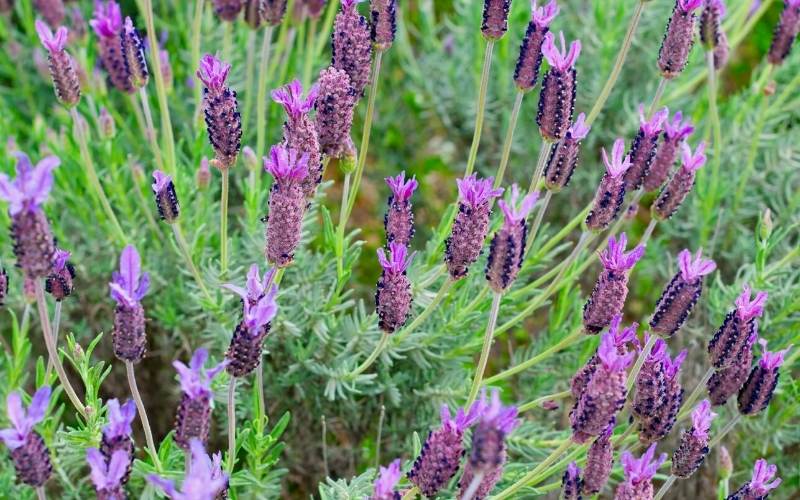
Picking a lavender variety for summer blooms is hard, but we chose ‘Anouk’ because of its showy flowers and vigorous growth. It is less fragrant than English lavender, but the flowers have bract like petals at the top that make them look like the wings of butterflies.
This distinctive shape is accompanied by a very bright magenta color. The silver green aromatic foliage adds to the luminosity of this small shrub with upright needle like leaves that form a very dense and compact shrub. And butterflies, bees and pollinators will hover over them in large numbers.
‘Anouk’ butterfly lavender is a low maintenance shrub with lots to offer to borders and beds, in most gardens, including rock gardens, gravel gardens, urban and rural settings. Dead head it for repeated blooms.
11. ‘Michael Lindsey’ California Allspice (Calycanthus floridus ‘Michael Lindsey’)

For a very unusual color in your summer garden try ‘Michael Lindsey’ California allspice. The cupped flowers with a rosette shaped and scale like petals (tepals) appear in the armpits of the bright green herbaceous and elliptical leaves and they really stand out.
Why? Because they are of the darkest maroon shade you can see, almost black! They are about 2 inches across (5.0 inches) and they look like oddly colored magnolias.
When the blossoms are spent, the foliage turns yellow for a final burst of color in fall. It has received the Gold Medal Award by the Pennsylvania Horticultural Society.
‘Michael Lindsey’ California allspice will look great in borders, beds, but you can also grow it as a specimen or in foundation planting in informal gardens, and it loos stunning in naturalized areas, especially at the edges of meadows and prairies.
12. ‘Diana’ Rose of Sharon (Hibiscus syriacus ‘Diana’)
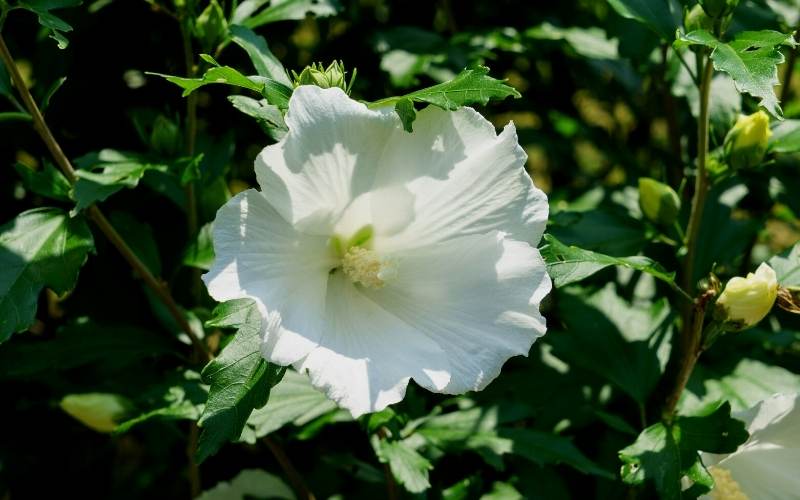
‘Diana’ is a showy variety of rose of Sharon that will brighten up both summer and fall with its large and snow white flowers. The round and paper like blooms are about 5 inches across (12 cm) and even the central stamen typical of Hibiscus species is of this candid color.
They are saucer shaped and abundant on the end of the branches. The emerald green and rich foliage is the perfect backdrop for the blossoms, and you can train this shrub into a small tree if you wish to.
It has won both the Award of Garden Merit by the Royal Horticultural Society and the Gold Medal of the Pennsylvania Horticultural Society, not bad at all!
Grow it as foundation planting or in hedges and borders in any informal garden, from cottage to urban; it is showy enough and easy enough to prune even to fit it into more formal designs.
13. ‘Ruby Spice’ Summersweet (Clethra alnifolia ‘Ruby Spice’)
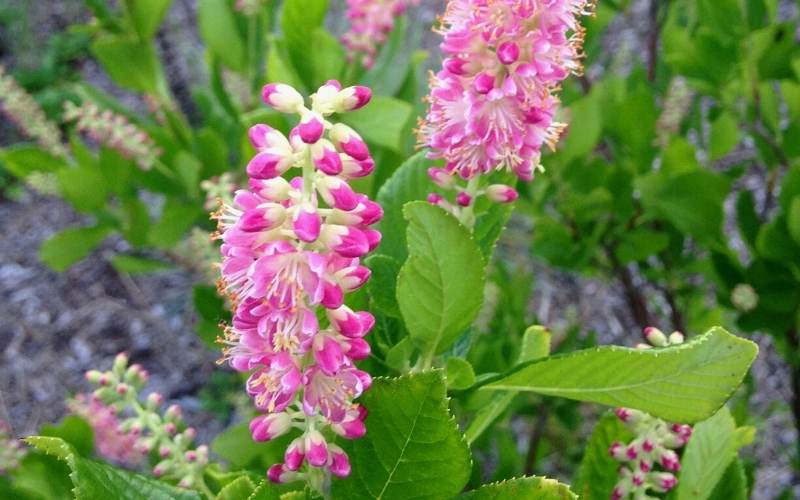
Summersweet has our season in its name, and ‘Ruby Spice’ is a very bright and vibrant variety perfect for your summer garden.
The blooms appear thick on spikes with fragrant star shaped white florets with shocking pink tips. They are also filled with many long pistils with golden anthers, to complete the effect of vitality and light!
They will point up from herbaceous stems covered in bright green, broad and long elliptical leaves and they will start opening from the bottom.
This spectacle will start in midsummer and you will still enjoy it well into the days of fall. It is a compact and hardy variety, ideal for northern states and Canada, and it has won the Award of Garden Merit by the Royal Horticultural Society in London.
‘Ruby Spice’ is the perfect deciduous summer-flowering shrub you want to lift up naturalistic perennial borders and to reflect its beauty into ponds and streams, as it is ideal for wet places. It is also ideal for shady gardens and green alcoves.
14. ‘Hardy Red’ Oleander (Nerium oleander ‘Hardy Red’)
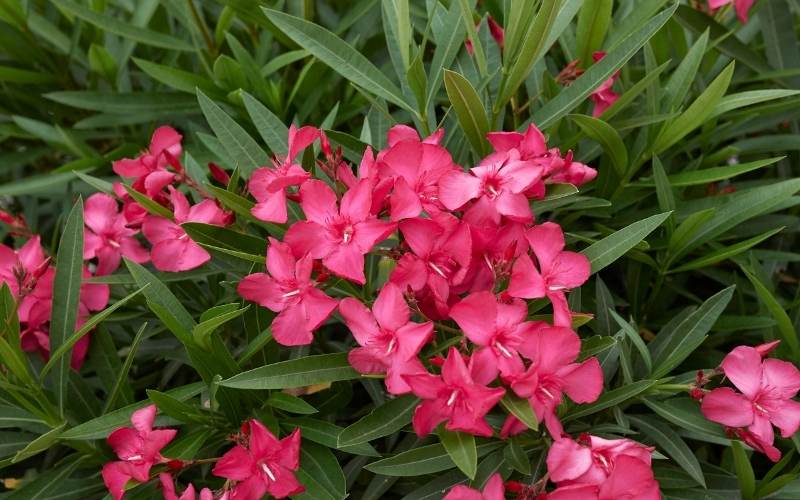
All oleanders will give you great colorful shows in summer, but ‘Hardy Red’ has the extra factor. This multi-stemmed evergreen shrub will wow you with the intensity and depth of its funnel shaped cherry to ruby red flowers. They will come with their fragrance at tips of the branches but also further down inside the shrub itself.
The evergreen foliage with its long and green leaves functions as the perfect frame for this fiery picture. The overall shape of the bush will resemble a vase, giving your garden structure all year round.
‘Hardy Red’ is perfect for warm gardens, like Mediterranean and coastal ones, but in borders and hedges you can enjoy it in most informal designs, from traditional English country gardens to urban and gravel ones. I
t is also a fairly hardy variety of oleander, suitable for many regions of the USA and not just the southern states.
Summer Shrubs with Flowers in the Sun
Summer is a fertile time of the year, and it’s also vacation time. Get the best out of both and grow low maintenance shrubs with lots of flowers, so your garden will keep bright and colorful when the Sun is hot, whether you are sipping a cocktail with your friends in your back yard or on a tropical beach!

Written By
Amber Noyes
Amber Noyes was born and raised in a suburban California town, San Mateo. She holds a master’s degree in horticulture from the University of California as well as a BS in Biology from the University of San Francisco. With experience working on an organic farm, water conservation research, farmers’ markets, and plant nursery, she understands what makes plants thrive and how we can better understand the connection between microclimate and plant health. When she’s not on the land, Amber loves informing people of new ideas/things related to gardening, especially organic gardening, houseplants, and growing plants in a small space.
